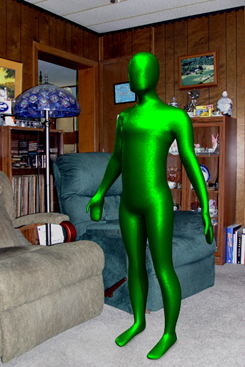Art, Science, Technology P - R
Numbers are indexed as words (3 = three, 8 = eight)
Plastidroid: A robot based on holographic quantum dot technology which is able to change its shape and composition (morph) into some other form, "living" or otherwise.
Plastidroids are one of the most controversial holographic quantum dot (HQD) products developed by Dr. Gina Verucchio at Claudius Electronics in Roma, capital of Italy prefecture on the planet Panjandrum.
Although the Stellar Economic Community quickly banned the use of HQD living tissue technology to produce humans, Taupoians, etc., Dr. Verucchio pointed out to the Claudius Board of Directors early on that no one objected to the ownership and use of Taupoian AI computers.
These computers had been used in starships, other types of vehicles, homes, and businesses for years. Claudius Electronics obtained a license for this technology and Verucchio was able to combine it with her quantum dot technology. The result is the plastidroid, which after several years of development, was first marketed in 2405.

The plastidroid is an HQD product that can be programed to look and behave like, for example, a human, but which is in reality a robot, albeit a very life-like robot. Like any other HQD product, it can not be distinguished from the real thing by conventional scanners.
Like AI computers, plastidroids can be aware of morals and laws, but have no built-in morals, which vary from culture to culture. However, unlike AI computers but like the life forms they mimicked, they can learn morals, and so they might eventually learn to question or refuse orders to perform some immoral or illegal act.
Similarly, a plastidroid has no emotions. These, too, have to be learned. Owners sometimes provide special schooling to prepare plastidroids for whatever role or roles are planned for them.
One special emotion that a plastidroid is programmed to learn is to bond with its owner. However, this bond is actually to the individual who spends time with the plastidroid and provides most of its control. An owner who has a plastidroid for the purpose of providing security for a son or daughter might find the plastidroid bonding with the child. In most instances, this is not considered a bad thing.
The default form of a plastidroid is a featureless, unisex "manikin" representing the typical size and shape of the race of the purchaser, but with the traditional metallic-green appearance. Each has a reset button somewhere on its person, but since they are individually crafted, the location varies from specimen to specimen.
Plastidroids can also be controlled or rebooted from the owner's personalized programmer. In many cases, the programmer is produced in the form of a ring or other jewelry because it is easily kept on the owner's person and its function is not obvious.
Orders can be given via the programmer, by voice, or some other audiovisual media. Likewise, the plastidroid can download a program specifying the form it is to morph to (with or without clothing), or it can create its own program from images or its owner's instructions.
Because the plastidroid is designed primarily to resemble a living being it is powered the same way that other living things are--from chemicals in its environment. For animals, this is food that such an animal eats. Plastidroids can also morph to plants which get chemicals through their root systems and, if photosynthetic, can get energy from the sun. A plastidroid, in any form, can also absorb light photoelectrically to power itself. As with other HQD products, plastidroids can receive energy via subspace, surreptitiously if necessary.
Plastidroids are not restricted to forming living things. Some owners, for security or intelligence purposes, morph their plastidroids into doors, statues, etc. The AI component remains active in these states.
Since plastidroids are much smaller than the typical starship, their memories are much more limited. To get around this, much of their memory is stored in the High Plane, like other important data. The memory is compartmentalized for each form that the plastidroid takes on. For example, if the plastidroid is Juan today, Gloria next week, and Phil a couple of weeks from now, memories need to be kept separate so that Phil will remain "in character" at all times. He mustn't accidentally speak the language of or do something characteristic of Gloria or Juan. However, if needed, these other memories can be accessed. Storing memory on the High Plane also allows the plastidroid to have much more memory than an ordinary person. Memory dedicated to one plastidroid cannot be accessed or transferred to another.
Because plastidroids are individually fabricated, they are fairly expensive, but not necessarily out of the reach of many ordinary people.
Although plastidroids are "just" expensive robots, the fact that they could be programmed and taught to resemble any intelligent planetary life form caused much of the same type of controversy as the potential for creating HQD people. Some thought that a plastidroid should be able to own itself. If so, should they be able to own other property as well? Could they marry, vote or hold public office? Would a plastidroid that committed a crime be punished? After all, we don't punish the getaway car for bank robbers. What if a plastidroid heard its master ask, "Will no one rid me of this troublesome priest?" How close to being "human" is a plastidroid?
As the years progressed, a number of distressing things became apparent. A man with a mid-life crisis might exchange his wife for "arm candy" provided by a plastidroid. Domestic disputes sometimes resulted in murder with the dead spouse being replaced by a plastidroid. Victims of other murders were sometimes replaced by plastidroids. Impressive, but fake, dossiers have been created and plastidroids were elected to public office or installed as the Chairman of the Board or CEO of some company. Others have been substituted for criminals before their incarceration. More than one college professor "retired early" by sending a plastidroid doppelganger to teach his class and to do his research.
Abuses were as ingenious and as common as the human--or alien--mind could imagine. So, about 110 years after their introduction, the SEC finally declared plastidroids illegal. "All" were recalled, deactivated, destroyed, and, eventually, forgotten.
Porcelain Horologe/Hourglass: A device for keeping time on Fohia. Because the Daily Glare produces only indistinct shadows at best, the Fohen have no sun dials. They have never discovered glass and have no mechanical timepieces. They use an hourglass-like item to tell time, but because it is porcelain, they cannot see the sand falling. They tell when the top chamber is empty by hearing the last grain fall to the bottom. Although all Fohen have excellent hearing, they must have superior hearing to be able to do that. The responsibility for selecting Fohens with the superior hearing, for constructing the porcelain horologes, and for announcing the time are given to local Horological Societies.
Because the Daily Glare produces only indistinct shadows at best, the Fohen have no sun dials. They have never discovered glass and have no mechanical timepieces. They use an hourglass-like item to tell time, but because it is porcelain, they cannot see the sand falling. They tell when the top chamber is empty by hearing the last grain fall to the bottom. Although all Fohen have excellent hearing, they must have superior hearing to be able to do that. The responsibility for selecting Fohens with the superior hearing, for constructing the porcelain horologes, and for announcing the time are given to local Horological Societies.
Purse portal: The communications technology and a teleportal small enough to fit in a lady's purse which allows the user to purchase small items, such as food or clothing, and remove them from the purse. Introduced to Earth by the Taupoians. (Red Sky in Mourning)
Quantum chain: A gold-colored chain whose existence depends on whether or not its wave function is collapsed, something which is determined by how it is used. (The Ring)
Quantum dot technology: see Holographic Quantum Dot Technology
Quantum lock pick: A small device based on quantum dot technology programmed to open a variety of locks. It can detect the type of lock and simulate or override whatever "key" is called for. Lock picks can be disguised as a variety of jewelry or other objects that the owner might legally carry. (The Lighthouse at the End of the World)
Ram Ship: A special type of Fohen airship designed to attack and destroy other airships. It has a long, narrow methane bag. The ship's cabin, which contains the controls and the steam engine, is attached to the stern of the methane bag and is supported by two smaller methane bags. The front of the main bag sports a sharp spear and the prow has a saw-toothed set of sharp blades for inflicting damage on other ships. The ram ship in this IMAGE is based on the Ramming Zeppelin model created by 1971s and available from Renderosity.
Reader: see Magic Slate
Red Flash: Sara Leone's red Tramontana sports car. (Shuttle 54, Where R U?)
Royal Glass: A type of glass invented by the ancient Waxonians. Light passing into the glass is absorbed and intensified before being refracted or reflected. Diffraction gratings are sometimes included in the glass so that light coming out is diverged into a spectrum even when the glass is not prismatic. These gratings can create patterns of light rather than just the normal "rainbow" effect. Reflected light from the gratings can give the glass a particular color. Gratings in the Crown of Ramunus gave it an intense blue color. Because of its molecular structure, items made from Royal Glass are almost unbreakable. (Royal Glass)
Runabout: Generic name for an off-road vehicle (One Potato, Two Potato)
Page updated: 04 January 2022
Page created: 19 January 2012